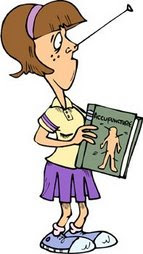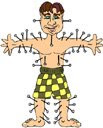Attention deficit hyperactivity disorder (ADHD) is one of the most common behavioral conditions among children. In the United States alone, approximately 4.5 million children between the ages of 5-17 years old are diagnosed with ADHD each year. Research indicates that when treating ADHD, a multidisciplinary approach is most effective; combining behavioral therapy, exercise, dietary changes and medication. Now acupuncture can be added as one of the treatment methods that can successfully manage ADHD.
What is ADHD?
Attention Deficit/Hyperactive Disorder (ADHD) is a condition of the brain that makes it difficult to concentrate or control impulsive behavior.
Children with ADHD generally struggle with paying attention or concentrating. They can't seem to follow directions and are easily bored or frustrated with tasks. They also tend to move constantly and are impulsive, not stopping to think before they act. These behaviors are generally common in children. But they occur more often than usual and are more severe in a child with ADHD. The behaviors that are common with ADHD interfere with a child's ability to function at school and at home.
Adults with ADHD may have difficulty with time management, organizational skills, goal setting, and employment. They may also have problems with relationships, self-esteem, and addictions.
Treatment for ADHD
Treatment for ADHD is multifaceted. It consists of ADHD medications, behavioral therapy and lifestyle and dietary modifications. ADHD is best managed when families, educational and health professionals work together to meet the unique needs of the child or adult who has ADHD to help them learn to focus their attention, develop their personal strengths, minimize disruptive behavior, and become productive and successful. Acupuncture is an excellent addition to any treatment plan as it is used to help the body restore balance, treating the root of the disorder, while also diminishing the symptoms of ADHD.
What acupuncture can help with:
• Improve focus and attention
• Manage moods
• Reduce fidgeting
• Lower hyperactivity
• Augment mood management techniques
• Enhance concentration
If you would like to learn more about acupuncture in the treatment for ADHD or one of the childhood ailments listed below, please call for a consultation.
What is ADHD?
Attention Deficit/Hyperactive Disorder (ADHD) is a condition of the brain that makes it difficult to concentrate or control impulsive behavior.
Children with ADHD generally struggle with paying attention or concentrating. They can't seem to follow directions and are easily bored or frustrated with tasks. They also tend to move constantly and are impulsive, not stopping to think before they act. These behaviors are generally common in children. But they occur more often than usual and are more severe in a child with ADHD. The behaviors that are common with ADHD interfere with a child's ability to function at school and at home.
Adults with ADHD may have difficulty with time management, organizational skills, goal setting, and employment. They may also have problems with relationships, self-esteem, and addictions.
Treatment for ADHD
Treatment for ADHD is multifaceted. It consists of ADHD medications, behavioral therapy and lifestyle and dietary modifications. ADHD is best managed when families, educational and health professionals work together to meet the unique needs of the child or adult who has ADHD to help them learn to focus their attention, develop their personal strengths, minimize disruptive behavior, and become productive and successful. Acupuncture is an excellent addition to any treatment plan as it is used to help the body restore balance, treating the root of the disorder, while also diminishing the symptoms of ADHD.
What acupuncture can help with:
• Improve focus and attention
• Manage moods
• Reduce fidgeting
• Lower hyperactivity
• Augment mood management techniques
• Enhance concentration
If you would like to learn more about acupuncture in the treatment for ADHD or one of the childhood ailments listed below, please call for a consultation.
Children respond extremely well to acupuncture treatments for many conditions. When treating children, their comfort is of the utmost importance. Treatments tend to be shorter and acupuncture points are usually stimulated gently with very thin needles or with other techniques that do not involve needles.
Needle-free acupuncture treatments may include stroking, rubbing, tapping, and pressing the acupuncture points with tools such as brushes, rollers and blunt probes.
Common childhood conditions treated with Oriental Medicine:
• Failure to thrive syndrome
• Weak constitution
• Colic, excessive night crying, temper tantrums
• Indigestion, GERD, constipation, and diarrhea
• Night terrors
• Attention deficit hyperactivity disorder (ADHD)
• Allergies, asthma
• Cough and colds
• Eczema and hives
• Ear infections
• Bedwetting
Needle-free acupuncture treatments may include stroking, rubbing, tapping, and pressing the acupuncture points with tools such as brushes, rollers and blunt probes.
Common childhood conditions treated with Oriental Medicine:
• Failure to thrive syndrome
• Weak constitution
• Colic, excessive night crying, temper tantrums
• Indigestion, GERD, constipation, and diarrhea
• Night terrors
• Attention deficit hyperactivity disorder (ADHD)
• Allergies, asthma
• Cough and colds
• Eczema and hives
• Ear infections
• Bedwetting
Ginger: Tool in Global Fight Against Childhood Killer?
That’s the promise pointed at by a study published in the American Chemical Society’s Journal of Agricultural and Food Chemistry.
In this study, researchers in Taiwan looked at the role of a ginger extract in blocking the toxin that causes 210 million cases of diarrhea worldwide. The toxin is produced by enterotoxigenic E. coli, which accounts for 380,000 worldwide deaths annually. The study found that zingerone, a compound in ginger, was the likely compound responsible for blocking the toxin.
Further study is needed to confirm these findings and determine appropriate dosage, especially for infants. But this natural wonder offers a very inexpensive alternative to drug therapy and great hope to thousands of children in poor countries around the world.











